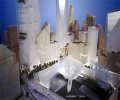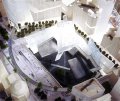






Okay here's where we get our first Glimpse of the New World Trade Center Towers!This is the plan we need,so as to send the message that We're not gonna let someone else run our lives or make us live in fear!The plan for the World Trade Center area includes a museum at the epicenter of Ground Zero, as well as two large public spaces called the �Park of Heroes� and the �Wedge of Light,� which would be laid out in such a way that the sun would shine down on them unblocked by anything on the anniversaries of the attack. The plan also includes a 1,776-foot tower.
NEW YORK, Feb. 26 (UPI) -- Daniel Libeskind's design incorporating the twin towers' foundation walls was chosen Wednesday as the plan to rebuild the World Trade Center, The New York Times reported.
Libeskind's design focuses on the underground walls, built to withstand the Hudson River known as the "bathtub" that contained the remains of the collapsed and soldering twin towers, which he says, represent the foundations of democracy.
The towers collapsed Sept. 11, 2001, after hijacked jetliners were crashed into them. Nearly 3,000 people died in the attacks.
"I named the project Memory Foundations because I believe it to be about the memory of a day that altered all of our lives, altered them forever; and I call it foundations because it's about the foundations of the future of New York," Libeskind said describing his design when it unveiled last December.
"I arrived by ship to New York as a teenager as millions before me did and my first sight was of the Statue of Liberty and the amazing skyline of Manhattan, I have never forgotten that sight or what it stands for."
The formal announcement of the decision made by the committee charged with choosing the design is scheduled Thursday. The committee is made up of representatives of the Lower Manhattan Development Corp., the Port Authority of New York and New Jersey, Gov. George Pataki and New York City Mayor Michael Bloomberg.
Libeskind's design, that includes a series of angular buildings and a 1,776-foot spire, was a favorite of Pataki, Bloomberg, many of the family members of the victims of the 9/11 attacks, and the public.
It was chosen over the design of the THINK team's "World Cultural Center" plan -- most reminiscent of the twin towers -- two 1,665-foot latticework towers that straddled the footprints of the original towers that included numerous cultural facilities.
The Libeskind design was a favorite of many New Yorkers when it was unveiled with eight other plans on Dec. 18, however, the THINK plan gained more support in the final weeks of the architectural competition.
Both plans of the two finalists called for the tallest buildings in the world, surpassing Malaysia's 1,483-foot Petronas twin towers. The World Trade Center's twin towers were 110 stories tall and stood 1,350 feet tall.
Studio Daniel Libeskind, based in Germany, has won several design competitions but never had a building built until the Jewish Museum in Berlin.
The memorial, located in the southwest corner of the site within the charred foundation walls, will be designed in another international design competition.
Underneath the site will be a transportation hub for Lower Manhattan. It's expected the 16-acre site will be completed within 10 years.
Among the issues that will have to be addressed by rebuilding officials is where to locate a bus parking area for an expected 120 tourist buses a day.
Also under contention is the amount of commercial office space allocated to the site, who will pay for the memorial and what the towers will look like.
The design decision began last summer when six plans to rebuild the World Trade Center were unveiled, however many described them as "boring" and "pedestrian."
The plans were constrained by Port Authority of New York and New Jersey requirements to replace 11 million square feet of office space and 600,000 square feet each of retail and hotel space that were lost in the collapse of the towers and other buildings nearby.
After the negative pubic reaction, another design competition was announced attracting hundreds of applicants. The competition was reduced to seven architectural teams that produced nine designs.
Rebuilding officials dropped the office space requirement to 6.5 million square feet and a requirement to not build on the footprints of the twin towers among other guidelines.
When Libeskind finished his first presentation of the design, of the excavated pit where the memorial would be ringed by jagged glass towers that swirled up to a towering, vertical garden, 1,776 feet tall, the crowd of family members, architects, city and state officials and other civic leaders burst into applause.













